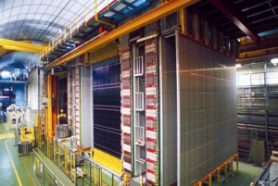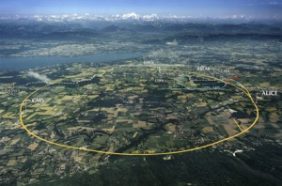Breaking the universal speed limit
Particles appear to race faster than the speed of light
Once upon a time, the brilliant physicist Albert Einstein argued that the universe has a speed limit. The year was 1905, and the speed limit was the speed of light. He argued that no particles, people or spaceships can ever travel faster than light, be it the beam from a flashlight or the blazing explosion of a supernova. Ever since then, light has been viewed as the fastest way to get across the universe.
Until now. Maybe.

“This will be a tremendous revolutionary finding if it is true,” Chang Kee Jung told Science News. Jung is a physicist at Stony Brook University in New York who studies neutrinos. Physicists study energy and matter to learn more about natural laws that govern the universe. He, like other researchers, is fired up about the discovery but thinks it’s too good to be true. He suspects scientists will find a mistake eventually.
But the mistake hasn’t appeared yet.
The difference in speeds is tiny. If one of these zippy neutrinos raced a light beam to the moon and back a million times, the neutrino would win by about a minute. But even a little bit counts: If Einstein was wrong about the speed of light being the fastest speed in the universe, then other parts of his theories about time, matter and energy also might not hold up.
If other researchers can confirm the neutrinos’ speeds, “this may mean that there’s much more going on in particle physics than we thought possible,” Matthew Mewes told Science News. Mewes is a theoretical physicist at Swarthmore College in Pennsylvania. Theoretical physicists try to understand and predict behaviors of matter and energy that have not necessarily been observed.

In the recent experiment, the neutrinos started their journey at CERN, a giant laboratory with experiments designed to study the smallest particles. CERN is near Geneva, on the border between Switzerland and France. Machines at CERN fired a stream of protons at a chunk of graphite, the same material found in pencil lead, which caused a stream of neutrinos to pour out.
Neutrinos can travel through almost any material without slowing down or stopping because they’re loners by nature that barely interact with anything else. (They’re also everywhere. Billions of neutrinos just zoomed through you. And billions more.) The neutrinos from CERN traveled under the Alps and halfway down the boot of Italy before being detected at the Gran Sasso National Laboratory, home to the OPERA experiment.
Now, teams of researchers around the world are scrambling to time neutrinos in other detectors. Scientists won’t believe neutrinos are faster than light until someone else can do a similar experiment and get the same results. Which may not happen.
“This is a serious experiment, and these are serious people,” theoretical physicist Lee Smolin told Science News. Smolin works at the Perimeter Institute for Theoretical Physics in Waterloo, Canada. “At this point nobody sober would be willing to say that this is right.”







